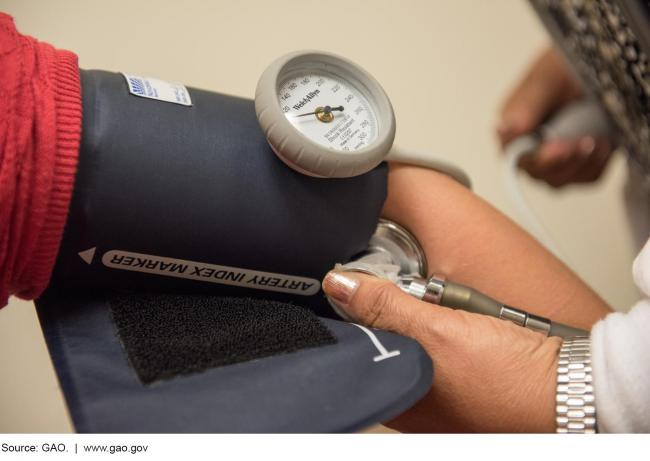Defense Health Care: TRICARE Surveys Indicate Nonenrolled Beneficiaries' Access to Care Has Generally Improved
Fast Facts
The Department of Defense offers health coverage to military servicemembers and retirees through TRICARE. Some beneficiaries—particularly those not enrolled in TRICARE’s managed care option—have raised concerns about finding doctors who accept their health coverage.
We reviewed DOD's most recent survey of TRICARE beneficiaries who were not enrolled in the managed care option and found that their access to care improved since the last survey. Specifically, these beneficiaries reported that it was easier to find doctors who accept TRICARE and get timely appointments with them.

Photograph of a medical professional taking a patient's blood pressure using a cuff.
Highlights
What GAO Found
The Department of Defense's (DOD) most recent surveys of TRICARE beneficiaries and civilian health care providers show that access to care has generally improved for nonenrolled beneficiaries who used the TRICARE Standard and Extra options. Specifically, GAO found the following:
- Nonenrolled beneficiaries reported improved access to care in the most recent 4-year survey (2012-2015), compared to the prior survey (2008-2011). For example, a lower percentage of nonenrolled beneficiaries reported that they experienced problems finding a civilian provider in the most recent survey (29 percent) than those in the prior survey (31 percent). In addition, a higher percentage of nonenrolled beneficiaries (90 percent) reported that they were usually or always able to obtain a non-urgent appointment as soon as they thought they needed compared to the prior survey (87 percent).
- The percentage of nonenrolled beneficiaries who reported positive experience ratings of TRICARE ranged from 71 to 83 percent over five categories, including ratings of primary, specialty, and mental health care providers. These ratings were generally higher than the prior survey. When compared to other federal health plans, nonenrolled TRICARE beneficiaries' positive experience ratings of primary and specialty care providers were lower than those of Medicare fee-for service beneficiaries, but higher than those of Medicaid beneficiaries.
- The percentage of civilian providers who were aware of TRICARE increased from 82 percent in the prior survey to 84 percent. However, the percentage who accepted new TRICARE patients decreased from 58 percent to 55 percent. According to GAO's analysis of survey data, this overall decrease was mainly attributable to a decrease in mental health care providers' acceptance rates, as the acceptance rates for primary and specialty care providers remained unchanged. Network providers reported both higher awareness and acceptance of TRICARE than providers not in the network (referred to as nonnetwork providers). The biggest gap in both awareness and acceptance between network and nonnetwork providers was for mental health care providers:
- About 96 percent of network mental health care providers reported awareness of TRICARE compared to 72 percent of nonnetwork mental health care providers.
- About 79 percent of network mental health care providers reported accepting new TRICARE patients compared to 30 percent of nonnetwork mental health care providers.
- GAO's analysis of both the beneficiary and provider surveys identified locations in New York, Washington, Texas, and Washington, D.C. where access to providers may be particularly problematic. Specifically, in these locations, beneficiaries reported more problems finding providers who accepted TRICARE and providers reported lower acceptance of TRICARE, compared to national averages.
Why GAO Did This Study
DOD provides health care, including mental health care, to eligible beneficiaries through TRICARE. Beneficiaries who use TRICARE Prime, a managed care option, must enroll to receive care. Prior to Jan. 1, 2018, beneficiaries did not need to enroll for TRICARE Standard, a fee-for-service option, or TRICARE Extra, a preferred provider organization option (referred to as nonenrolled beneficiaries). Although the TRICARE Standard and Extra options were terminated effective Jan. 1, 2018, the new TRICARE Select option has similar benefits for obtaining care from network and nonnetwork providers.
The National Defense Authorization Act (NDAA) for Fiscal Year 2008 directed DOD to conduct surveys of nonenrolled beneficiaries and civilian providers about access to care under the TRICARE Standard and Extra options. It also directed GAO to review the surveys' results. Additionally, the NDAA for Fiscal Year 2017 included a provision for GAO to review access to care under TRICARE Extra. This report addresses both provisions.
GAO analyzed DOD's surveys to determine (1) nonenrolled beneficiaries' access to care, (2) nonenrolled beneficiaries' ratings of TRICARE, (3) civilian providers' awareness and acceptance of TRICARE, and (4) nonenrolled beneficiaries' access by individual geographic area. GAO interviewed agency officials, analyzed the 2012-2015 surveys, and compared them to DOD's 2008-2011 surveys and to surveys of Medicare and Medicaid beneficiaries. In commenting on a draft of this report, DOD concurred with GAO's findings.
For more information, contact Debra A. Draper at (202) 512-7114 or draperd@gao.gov.
